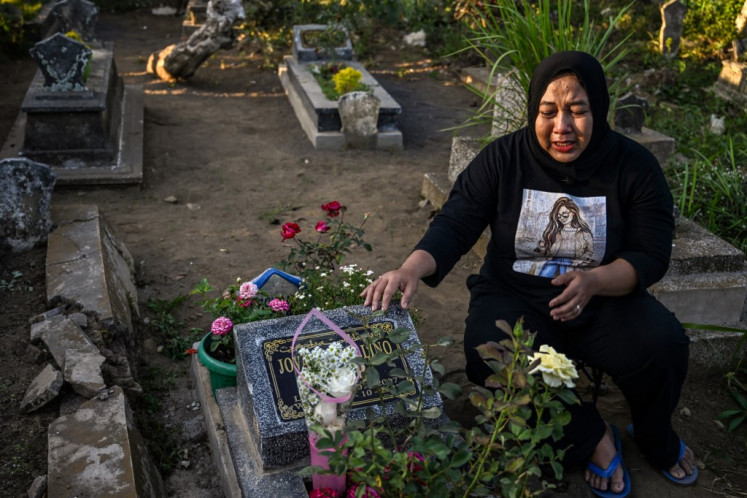Popular Reads
Top Results
Can't find what you're looking for?
View all search resultsPopular Reads
Top Results
Can't find what you're looking for?
View all search resultsMemories of the sacred
So you’ve arrived in Bali on a private jet, your wallet filled with platinum credit cards
Change text size
Gift Premium Articles
to Anyone
So you’ve arrived in Bali on a private jet, your wallet filled with platinum credit cards.
A rare sight: Up in the mountains around Apuan and Padang Dawe during the month of Galungan, villagers dressed up as the sacred Barong and Rangda, representing good and evil, go on a special tour through the area, staying at local temples on their journey and blessing the region.
And you wish to see the rarest and most grandiose of Balinese Hindu rituals, the very ceremonies that made anthropologists in the 1930s scramble for their pens and notebooks.
Well, your platinum plastics will certainly earn you a glitzy nest at one of the island’s newest, exorbitantly priced boutique hotels.
Your richer-than-Steve-Jobs attitude will no doubt open many doors at the island’s most exclusive clubs.
Yet, there are several things that money will not buy you in Bali. Those things are happiness, of course, sanity and some of the most beautiful Balinese Hindu rituals.
Those rituals have gone forever. Some have morphed into modern-looking, tourist-friendly processions with more expensive offerings and better-dressed participants.
Others have altogether disappeared because they lost their relevance. What’s the point of carrying out a ceremony to marry the rice stalks when the rice fields are no longer there?
For those still determined to catch a glimpse of these rituals, there is one viable option; Memories of the Sacred, veteran image maker Rio Helmi’s newest compendium of photos.
The book, which will be launched during the Ubud Writers and Readers Festival 2010, captures some of the rarest rituals in Bali, including those that can no longer be seen.
One of them is the Sakenan Temple’s anniversary ritual. In the old times, Hindus would march across the shallow muddy swamp separating Serangan Island, where the temple is located, from mainland Bali.
Now, the colorful procession across an empty landscape no longer takes place. A massive tourism development project on Serangan has not only enlarged the once tiny island through land reclamation but has led to the construction of a concrete bridge connecting the island with Bali.
From Java to Bali: Mountain girls wearing Rembang shoulder cloths — which traditionally come from Rembang, Central Java — take part in a ceremony in a village on the ridges running south and southwest from Kintamani, where traditions and beliefs are older than south central Bali’s Majapahit-influenced culture.
“Look at this procession in Padang Dawe, the landscape around the route has changed so much that a procession nowadays would not hypnotize you the way the old procession did,” Rio said, pointing to one of the pictures in the book.
“And there is no way that you could see this scene now,” Rio said, pointing to Back of the Bus, another photo taken in the early 1970s, capturing several men cramped at the back of a bus, the only regular transport between Ubud and Denpasar.
One of the book’s gems is the poignant essay written by Diana Darling, who understands the island more than the majority of Balinese people.
There’s a certain something — a wild, spangled energy — that once saturated Bali as tangibly as its own tropical humidity; something that could catch you in its teeth anywhere — on your way into the Kuta from the airport, say, as you rode along a sandy track on the back of a motorbike — and rattle your heart at the sight of children dancing with the slow dignity of gods; or that could hit you in the face like a sluice of cold champagne at the sight of clowns jousting in a graveyard, reducing you to a jelly of laughter even though you don’t understand a word they say; or that could freeze your skin in a cloud of chattering cymbals and drums as a corpse is carried out to the street through a house gate.
The Balinese word for this certain something is niskala, usually translated as “the invisible world” — potent and ambivalent, the big reality behind the surface we see, like some roiling, shimmering electrical milk, Diana eloquently wrote.
“In modern Balinese society, the importance of observing one’s obligations to the niskala is almost unquestioned. What is under pressure is the context in which these ritual obligations take place. Bali’s religious culture developed in an agricultural and deeply conformist society, where the ritual calendar reflected the rhythms of the rice-growing cycle and the seasons, where people survived [or not] with what they produced on their own land, and where there were few demands on their time beyond those of the village and the fields. To keep up the ritual surface of this culture today is ever more at odds with modern reality,” she said.
Diana’s ability to pierce through the island’s confusing layers of realities and expound the substances of its culture in simple words and Rio’s haunting images combine to make Memories of the Sacred such a powerful book. It is a book that moves us to lament those things we have lost forever.
— Photos Courtesy of Rio Helmi Memories of the Sacred
by Rio Helmi
Book launch on Saturday Oct. 9, 4:30 p.m.
Ary’s Warung, Jl. Raya Ubud (near Ubud Palace)











